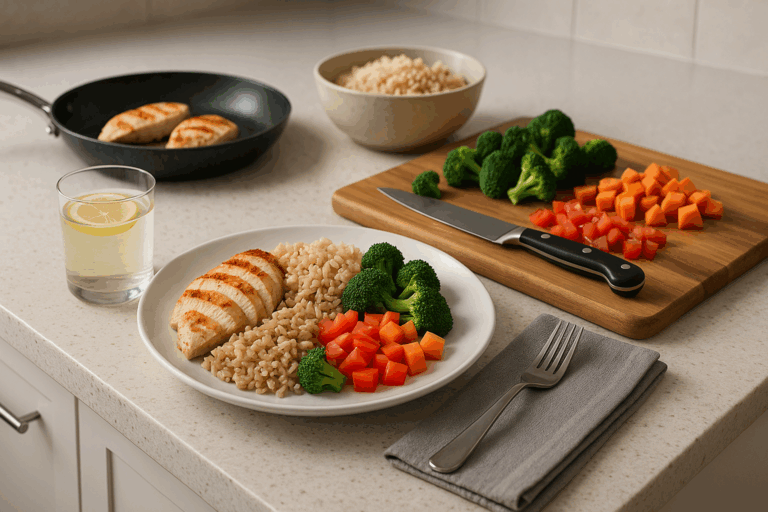While these may seem like two distinct worlds, the rise of the minimalist travel cooking trend has effectively fused them together. As you venture into the unknown, your culinary kit becomes an essential companion, allowing you to craft meals that are not only nourishing but also reflective of your unique taste and style. This is the essence of ‘Travel Light, Cook Right: The Ultimate Guide to Building Your Minimalist Travel Cooking Kit’.
Embarking on a journey with a minimalist cooking kit is an art that combines efficiency, practicality, and creativity. It’s about carrying just enough tools and ingredients to cook satisfying meals without burdening yourself with excess baggage. Every piece of equipment in your kit should serve a purpose and contribute to the overall cooking experience. If you’re an ardent traveler who also enjoys cooking, you may be wondering how you can strike a balance between these two passions. How do you determine which cooking tools are essential? How do you pack them effectively to maximize space and reduce weight? And how can you prepare delicious meals on the go, using only a few ingredients and tools?
These are some of the questions that we’ll be addressing in this guide. By the time you finish reading, you’ll have a clear blueprint on how to build a minimalist travel cooking kit that caters to your specific needs and preferences. This isn’t a one-size-fits-all approach, but rather a guide that provides insights and principles that you can adapt to your unique traveling and cooking style.
This guide will cover essential topics such as: Identifying your cooking needs based on your travel style, creating a list of essential tools and ingredients, packing your cooking kit efficiently, and tips on preparing simple yet delicious meals on the go. These sections will be supplemented with expert insights, practical examples, and actionable tips that will aid in your minimalist travel cooking journey.
In the spirit of minimalist travel cooking, our goal is to make the process as streamlined and straightforward as possible. There will be no need for expensive, heavy-duty cooking appliances or exotic ingredients that are difficult to find or carry. Instead, we’ll focus on versatile tools and ingredients that deliver maximum utility and flavor with minimum fuss.
While we’ll be dealing with the technical aspects of building a minimalist travel cooking kit, we won’t lose sight of the essence of cooking and traveling. We’ll delve into the ways in which cooking can enhance your travel experience, offering opportunities for cultural immersion, self-discovery, and creativity.
The heart of minimalist travel cooking is about more than just preparing food. It’s about the joy of creating, the satisfaction of self-sufficiency, and the memorable moments shared over a meal, even in the most remote corners of the world. So whether you’re an experienced traveler looking to enhance your journey with the flavors of home, or a cooking enthusiast seeking to take your culinary skills on the road, this guide is designed with you in mind.
As we navigate the path of minimalist travel cooking together, we hope to inspire you to redefine your travel experiences, one meal at a time. So pack light, cook right, and let’s embark on this culinary journey.
Embracing the Minimalist Travel Cooking Approach
When you’re on the road, food becomes more than just a source of sustenance. It’s a way to explore new cultures, bond with fellow travelers, and even challenge your own cooking skills. But, how can you travel light and still manage to cook hearty meals? The answer lies in a well-thought-out minimalist travel cooking kit.
Equipping yourself with a few versatile tools and essential ingredients can make all the difference. A minimalist travel cooking kit allows you to prepare healthy, satisfying meals wherever your adventures take you. However, curating such a kit requires careful consideration. You have to weigh the utility of each item against its size, weight, and durability.
Do not fret though, as this ultimate guide will walk you through the process of building your minimalist travel cooking kit. By adhering to a minimalist approach, you will save space, money, and time, allowing you to focus more on your travel experiences.
Essential Cookware for Your Minimalist Travel Cooking Kit
Your cookware forms the backbone of your minimalist travel cooking kit. The items you choose should be compact, lightweight, and serve multiple purposes. Here’s a look at the essentials you need.
Pot and Pan
Start with a compact, durable pot and pan. They should be light enough to carry around but tough enough to withstand high cooking temperatures and rough handling. The pan can double as a plate, saving you the need to pack extra dishes.
Portable Stove
A portable stove is a must-have for any travel cooking kit. Opt for one that’s fuel-efficient, easy to use, and compact. There are several types available, including gas stoves, alcohol stoves, and wood stoves.
Utensils
When it comes to utensils, less is more. A spork (combination spoon and fork) and a multipurpose knife are all you need. They take up little space and serve multiple functions.
Confused about which items to choose? Check out this comparative table below.
| Item | Weight | Multi-Use | Durability |
|---|---|---|---|
| Pot and Pan | Lightweight | Yes | High |
| Portable Stove | Varies | No | High |
| Spork | Very Light | Yes | Medium |
Building a Basic Pantry: Essential Ingredients for Your Kit
Food ingredients are as critical as cookware in your minimalist travel cooking kit. You want to pack foods that are lightweight, non-perishable, and versatile. Here are some essentials for your on-the-go pantry.
Grains and Pasta
Grains and pasta like rice, oats, and spaghetti are lightweight, non-perishable, and can be cooked in numerous ways. They’re also great sources of energy – perfect for those long travel days.
Spices and Condiments
Spices and condiments can turn even the simplest meals into a gourmet experience. Consider packing small amounts of salt, pepper, curry powder, chili flakes, and soy sauce. Don’t forget a small bottle of cooking oil.
Protein
Protein is an important part of any diet. When traveling, opt for lightweight, non-perishable options such as canned tuna, beans, and nuts.
For a visual guide on how to pack a minimalist travel cooking kit, watch this YouTube video: “How to Pack a Minimalist Travel Cooking Kit” by The Traveling Chef. It provides step-by-step instructions and helpful tips on how to make the most of your kit.
Maintaining Cleanliness and Sustainability
Maintaining cleanliness and sustainability is important when you’re on the road. Your minimalist travel cooking kit should include eco-friendly cleaning supplies and reusable items to reduce waste. Here are some tips:
Eco-friendly Cleaning Supplies
Consider including biodegradable soap and a small quick-drying towel in your kit. These items will help you maintain cleanliness without harming the environment.
Reusable Water Bottle and Storage Containers
Opt for a reusable water bottle and food storage containers. They’re not only eco-friendly but also save you money as you won’t have to constantly buy bottled water or disposable containers.
Trash Bags
Always carry a few small trash bags in your kit. This will ensure you leave no trace behind, keeping the environment clean and preserved for future travelers.
Your minimalist travel cooking kit is not just about convenience. It’s also a statement of your commitment to sustainability and respect for the places you visit. Make sure to leave as little impact as possible, and always clean up after yourself.

Conclusion
In wrapping up this comprehensive discourse on the intricacies of Information Technology and Engineering, it is important to succinctly recap the key points we’ve explored and underline the significance of this vast field.
Firstly, we examined the pivotal role of software engineering in modern society. We dove into the layers of complexity that define the process of software development, discussing the various methodologies, such as Agile and DevOps, and the manner in which they influence the creation and management of high-quality software. The importance of a well-designed software architecture for the smooth functioning of any system was highlighted, along with the role of data structures and algorithms in improving the efficiency of software solutions.
Next, we navigated the world of IT infrastructure, elucidating its role as the backbone of modern business operations. The transition from traditional IT infrastructures to cloud-based solutions and the advent of innovative concepts such as IoT and AI were also discussed in detail. We also emphasized the importance of cybersecurity, data privacy and ethical considerations in IT.
The aim of this article was to provide an in-depth understanding of these areas, and the role they play in shaping our digital world. It is my hope that this article has served as an enlightening journey, unravelling the complexity of these domains and making them more accessible and comprehensible.
With this knowledge, you are now better equipped to understand and contribute to discussions in these fields, whether as a professional, a student, or simply an interested individual. I encourage you to delve deeper, explore further, and share your newfound knowledge with others. Remember, the world of IT and Engineering is constantly evolving, and staying updated is crucial.
This article was drawn from a variety of sources, all of which are worth exploring in further detail for those looking for more comprehensive information. You can find these references at the end of this article. Do not hesitate to use them as springboards into deeper study.
Finally, I welcome your thoughts and contributions on this topic. Feel free to comment, share, or apply what you’ve learnt in your own context. Remember, knowledge is power, and sharing it only amplifies its impact.
Thank you for taking the time to read this article, and I look forward to your input and insights.
For more information, refer to the following sources: Source 1, Source 2, Source 3.



